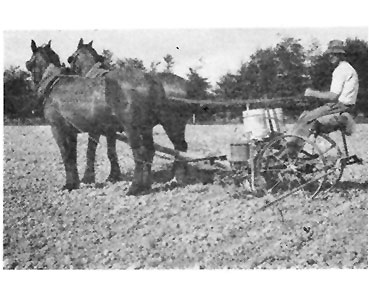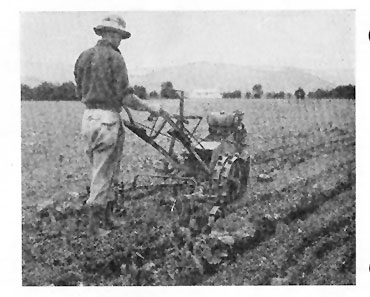Intercultivating duel crop with small power plant. Photo: ‘Maize Growing for Grain’ Bulletin No 269.
Sowing two to three rows of grain at a time and using trip wires to space the kernels evenly are a far cry from today’s modern maize planting methods.
However, they are among those described in ‘Maize Growing for Grain’ Bulletin No 269 – from the NZ Department of Agriculture that I found in some of the documents belonging to my late father-in-law, Harry Fisher.
The 28-page bulletin is dated March 1946 and was written by C Walker, an instructor in agriculture in Thames. It includes a series of black and white photographs of cultivation, planting and harvesting, using both tractor-driven and horse-drawn equipment.
Despite the decades since he wrote this bulletin, and the advances in technology, the author’s basic advice is as applicable today as it was then.
He talks about selecting the best areas for planting, careful preparation of the land before sowing and selecting varieties suited to the location. However, the methods of cultivation, sowing and harvesting are vastly different from today.
Preparatory work
“In preparing for maize one should aim at providing the best possible conditions of tilth by the time the seed is sown.
“In general, well-planned cultivation, spread over several months, will produce good results, but hurried cultivation is always likely to lead to disappointment. No amount of cultivation after the crop is sown can make up for any deficiencies in preparatory work,” writes C Walker.

The way it was – sowing maize with a two-row planter. Photo: ‘Maize Growing for Grain’ Bulletin No 269.
Intriguing is C Walker’s description of a system for spacing the plants. “A check system of sowing is adopted in the Gisborne district where the maize planter travels along wires stretched from end to end of the field being sown. Checks spaced about 34 inch apart on these wires trip the machine and allow two or three kernels of maize to be dropped at each spacing.
“This method…provides for spacing both ways so that subsequent inter-cultivations can be carried out in two directions, which is of great assistance where weeds are troublesome”.
Eleven varieties
The bulletin lists 11 main varieties of maize, and their attributes. They are Marigold, Prairie Queen, Funk’s Yellow Dent, Hickory King, Flint Types (including Motiti maize), Horsetooth, Early Butler, Excelsior, Large Yellow Dent, Silver Queen and Pfister Hybrid.
“The average yields for grain in this country is from 45 to 50 bushels of shelled maize per acre. Where conditions of soil and climate are particularly favourable, yields of over 100 bushels are fairly frequent,” writes C Walker. One bushel of corn equals just more than 25kg.







0 Comments
Leave a Comment